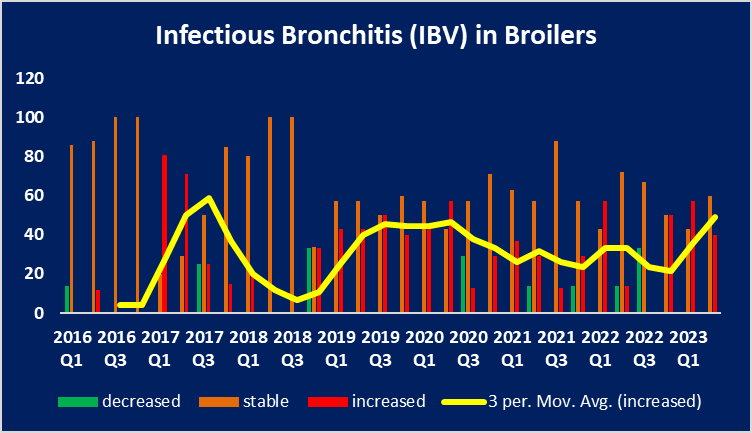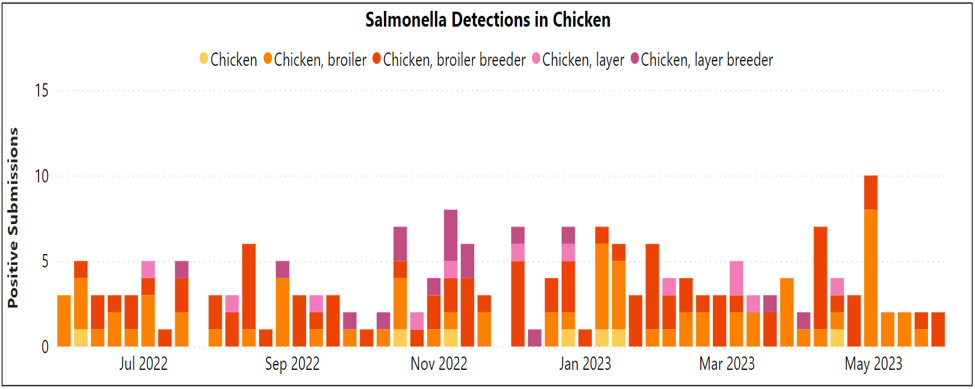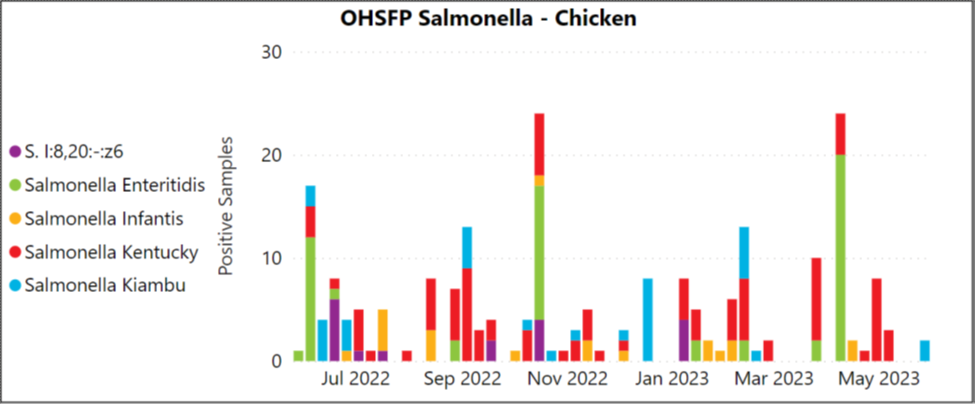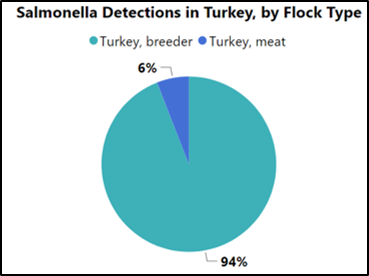Ontario Animal Health Network (OAHN)
Poultry Expert Network
Quarterly Producer Report
Weighing in on Precision Livestock Farming
France Lanthier, Livestock Specialist, Agriculture Development Branch
Ontario Ministry of Agriculture, Food and Rural Affairs
Weight gain remains one of the key lead indicators to assess both productivity and welfare in animal production operations1, and as such we will investigate two innovations in continuous weight monitoring for poultry operations.
Chicken production has witnessed remarkable growth over the past three decades2, with global numbers reaching 25.9 billion in 2019 and an astounding 80% increase in 2020. In Canada3, poultry production and sales rose by 14.0% to $4.2 billion in 2022, with chicken, turkey, and stewing hens totaling 1.5 billion kilograms. Egg production also increased by 2.2% to 866.5 million dozen. Chicken production specifically rose by 2.8% to 1.37 billion kilograms, accounting for 90.1% of total poultry production in Canada. Ontario played a significant role, contributing over one-third with 478.4 million kilograms of chicken and experiencing a 16.3% sales surge to $1.5 billion.
The dominance of poultry meat in global production is expected to continue growing, necessitating efforts to improve efficiency, quality standards, and animal welfare. Precision Livestock Farming (PLF), previously associated with cattle farming, is now being adopted in poultry production. PLF tools enable real-time monitoring and data collection on housing conditions and animal well-being, eliminating the need for direct human-animal interaction. By analyzing data from various sources, an automated management system can be established, ensuring high welfare standards, promoting natural behaviors, and addressing behavioral disorders that lead to economic losses.
Assessing animal behavior through real-time weight monitoring, becomes crucial for enhancing production efficiency and promoting animal welfare in the face of growing public concern.
Automatic platform or walk-through systems
An automatic animal weighing system consists of a smart control computer and platform or walk-through weighing scales within the facility, allowing for uninterrupted and continuous weighing of the animals. With the capability to register thousands of measurements per day, these systems provide a reliable and comprehensive understanding of the current situation, surpassing the limitations of manual weighing. Poultry weighing systems consider factors like average and expected weights based on previous measurements, offering a clearer idea of short-term expectations, and enabling accurate predictions of final weights. The smart algorithm in the control computer accommodates these factors, providing a reliable representation of average weights under various conditions. Continuous weighing provides an up-to-date overview of animal growth, enabling early detection of abnormal growth patterns for timely interventions. Additionally, the systems can reveal insights into animal activity, as a sudden reduction in activity may indicate potential issues. Early intervention is crucial to prevent problems such as feet issues, reduced feed intake, and lower growth. By generating timely alerts, the animal weighing system helps mitigate these concerns effectively. While automatic weighing scales offer many advantages, they do rely on the birds voluntarily visiting the scales. Chedad et al. (2003) reported that heavier birds visit weighing scales less frequently4 which could underestimate the average weight of the flock towards the end of production and falsely reducing the feed conversion ratio.
3D camera-based systems
Another technology that is continuously developing is the 3D camera-based system to provide real-time measurements of broiler weight. Its key advantage lies in the ability to monitor a wide range of birds below the camera, enabling accurate average flock weights and uniformity measurements. The online platforms allow users to analyze weighing data online, facilitating informed decision-making and gaining valuable insights into production. Ongoing development introduces new features, such as measuring dead birds and bird density, and assessing bird activity and posture for deeper production insights. The units are strategically installed in the house, establishing network connectivity, and providing instant access to online growth curves and uniformity data. This technology incorporates 3D camera technology, smart algorithms, and the units come equipped with a built-in computer and networking capabilities. The algorithms are refined based on extensive analysis of millions of images and manual broiler weighs. While these systems are becoming highly sophisticated and the algorithms increasingly reliable, they tend to lend themselves better when installed during a new build and in areas with reliable internet services. Retrofitting these systems in older buildings could be challenging and costly.
There is no doubt that both these systems facilitate the monitoring of animal welfare, health, and performance. It is however critically important that the compatibility of precision tools with existing commercial poultry farm equipment and practices be carefully assessed prior to investing in these PLF technologies.
References
- Manning, L., et al. 2007. Key health and welfare indicators for broiler production. World’s Poultry Science Journal. 63(1): 46-62.
- Production of meat worldwide from 2016 to 2022, by type. https://www.statista.com/statistics/237632/production-of-meat-worldwide-since-1990/
- Poultry and egg statistics, May 2023 and annual 2022. https://www150.statcan.gc.ca/n1/daily-quotidien/230530/dq230530d-eng.htm
- Chedad, A., et al. 2003. Do heavy broiler chickens visit automatic weighing systems less than lighter birds? British Poultry Science. 44 (5): 663-8.
Poultry Veterinarian Survey Highlights – Q2 2023 (Mar-May)
Broilers
Early systemic bacterial infection (<14 d old) – ESBI
AHL: The number of cases were stable from last quarter and similar to Q2 2022. All cases had at least E. coli isolated either in pure culture or in combination with E. cecorum, P. aeruginosa, or Salmonella arizonae.
Practitioners: Practitioners indicated stable to increased cases this quarter especially during April. Most cases were attributed to Escherichia coli bacteria but also Enterococcus cecorum and Pseudomonas were identified in the broiler flocks.

Ascites
AHL: No cases of ascites were diagnosed this quarter.
Practitioners: Reported as mainly stable with equal number of responders reporting decreased and increased cases.
Coccidiosis and necrotic enteritis
AHL: Cases of coccidiosis were stable compared to the last 3 quarters and cases of necrotic enteritis were slightly decreased compared to the previous 2 quarters. The majority of coccidiosis cases were identified in the small intestine.
Practitioners: Cases of coccidiosis were reported as stable, whereas necrotic enteritis cases were mainly stable to decreased for this quarter.
Inclusion body hepatitis (IBH)
AHL: Histologic cases increased to similar levels seen in Q2 2022 and viral isolations were also increased. On Fowl adenovirus PCR, the most common species was FAdVE but in some cases all 3 species were now identified as positive (FAdVE, FAdVD, FAdVAC). As in previous quarters, on sequencing the primary strain identified was FAdV08b (i.e., FAdV08b_AHL_16-049095_ON and FAdV08b_AHL_18-057921_ON). Viral isolation also identified FAdV11_USA_1047. These findings were the same as last quarter.
Practitioners: Practitioners reported increased cases this quarter, especially during April with one responder reporting stable cases. Overall, affected flocks were experiencing nearly 13% mortality related to this condition.
Infectious bursal disease
AHL: The number of pathology cases as well as virus isolations were slightly decreased compared to the previous quarter. On sequencing there were predominantly field strains identified with the most common being USA PA105-2014 field strain. Other strains identified included USA Del-E field strain, and USA 66-Indiana-2014.
Practitioners: Reported as stable to slightly increased cases this quarter.
Infectious bronchitis (IBV)
AHL: The number of pathology cases were stable and the number of virus isolations was increased compared to the previous quarter. Vaccines strains were primarily identified on sequencing as well as 1 DMV strain (IBV_DMV_ON_21-017385).
Practitioners: IBV detection was reported stable by the majority of the responders with two practitioners reporting increasing cases for this quarter.

Spiking mortality
AHL: No cases of spiking mortality were diagnosed this quarter.
Practitioners: Reported as stable to slightly decreased for this quarter.
Salmonella
Practitioners: Salmonella isolations were reported as stable to slightly increased this quarter. The most common serotypes isolated were S. enteritidis, S. Typhimurium and S. Arizonae.
Histomoniasis (blackhead)
AHL: No cases of histomoniasis diagnosed this quarter.
Practitioners: Reported as stable.
Runting and Stunting Syndrome (RSS)
AHL: Confirmed and suspect cases of RSS (diagnosed on histology) were stable compared to the previous quarter.
Practitioners: RSS caused by astrovirus were reported as stable.
Other diagnostic findings
AHL: Other diagnoses made at the AHL included airsacculitis/heterophilic pneumonia, bone fracture (humerus), undefined peripheral nerve lesions, and thymic atrophy.
Practitioners: No specific findings by practitioners this quarter.
Condemnation issues
AHL: No condemnation cases in this quarter.
Practitioners: Issues were reported as stable to increased by veterinarians this quarter. Cellulitis was the most common cause of condemnations. It was noted up to 6% increase in condemnation rate on organic flocks related to a dorso-cranial myopathy condition diagnosed on post-mortem.
Slaughter provincial plants: The top condemnation conditions were reported as ascites, airsacculitis and cellulitis.
Slaughter federal plants: Sub-cutaneous lesions and emaciation were reported as the main conditions for condemnation.
Broiler-Breeders
Fowl cholera
AHL: Occasionally isolated from lameness cases from vaccinated flocks.
Practitioners: Reported stable to slightly increased this quarter in vaccinated flocks with high culling rate but low mortality.
Early bacterial infection (<14 d old)
AHL: The number of cases were slightly increased from the previous quarter. Cases had either E. coli isolated in pure culture or in combination with E. cecorum, or P. aeruginosa.
Practitioners: Reported as stable to increased cases with E. coli as the main isolated bacteria.
Other causes of early mortality (<14 d old)
AHL: There was 1 case of dehydration identified in this age group.
Practitioners: Reported as stable this quarter.
Prelay morbidity/mortality (<20 weeks)
AHL: The case numbers were similar to Q2 2022 and Q1 2023. Cases of septicemia had either S. aureus isolated in pure culture or combined with E. coli. E. coli and E. cecorum were isolated in combination or additionally with S. aureus or Bacteroides sp. Other diagnoses included mycotic pneumonia, intussusception/intestinal prolapse, coelomitis (E. coli, Salmonella), and fatty liver.
Lameness – bacterial
AHL: The case numbers were decreased from the previous 2 quarters but similar to Q3 2022. Cases consisted of primarily pure culture of S. aureus. Other cases consisted of E. coli either in pure culture or combined with S. aureus.
Practitioners: Stable to slightly increased. Joints of affected birds examined in the field presented as an inflammatory process with either clear or purulent material identified. E. coli, E. cecorum and Staphylococcus aureus along with Pasteurella multocida were the most common isolates from the joints and bone marrow. It was noted that flare ups are mostly encountered when birds are exposed to stress related events (environmental pressure, fear and moving).
Lameness – viral, developmental and nutritional
AHL: There was one case of pododermatitis having E. cecorum isolated.
Practitioners: All reported as stable by responders.
In-lay bacterial septicemia
AHL: Cases decreased to half the number of cases from each quarter in the previous year. All isolations included at least 2 bacteria including primarily E. coli and E. cecorum together as well as in combination with S. suis or G. anatis. One case had isolation of E. coli, S. aureus, and G. anatis.
Practitioners: Septicemia was reported as stable to slightly decreased this quarter with E. coli the main isolated bacteria.
IBV- decreased production/ abnormal eggs
AHL: One case diagnosed this quarter based on suspicious histologic lesions.
Practitioners: Reported a shift from stable to mainly decreased cases this quarter.
IBV – sudden spike in mortality
AHL: There was a slight decrease in both pathology cases and virus isolations this quarter compared to the previous quarter. Strains identified included IBV_Mass-H120 vaccine, IBV_Mass-MA5 vaccine, IBV_DMV_ON_21-017385, and IBV_CA_1734_04_ON_12-025379.
Practitioners: Respondents were reporting decreased to stable cases.
Disease related hatchability issues
Practitioners: Reported as stable to slightly increased for this quarter.
Mycoplasmosis
AHL: No cases of mycoplasmosis diagnosed this quarter.
Practitioners: Stable to decreased condition reported this quarter.
Necrotic enteritis
AHL: No cases diagnosed this quarter.
Practitioners: The number of necrotic enteritis cases were reported as stable to slightly decreased.
Coccidiosis
AHL: Cases slightly increased from the previous quarter. Coccidia identified in the small intestines, ceca, or both the small intestines and ceca.
Practitioners: Generally stable number of cases reported. One respondent mentioned a decrease in cases compared with last quarter.
Fowl pox and ILT
AHL: No cases of fowl pox or ILT diagnosed this quarter.
Practitioners: Reported stable for this quarter.
Salmonellosis (clinical)/Salmonella isolation
Practitioners: Stable with a variety of Salmonella isolates including S. Kentucky, S. Uganda, S. Heidelberg, S. I rough-O: r:1,2, S. Livingstone, S. Mbandaka and S. Kiambu.



Aggression and cannibalism
AHL: One case of cannibalism diagnosed this quarter.
Practitioners: Cases were reported as stable.
Multi-drug resistant E. coli (resistant to >3 drugs)
Practitioners: Reported as stable.
Histomoniasis (blackhead)
AHL: No cases of histomoniasis diagnosed in this quarter.
Practitioners: Stable to slightly decreased cases reported by responders.
White Chick Syndrome
AHL and practitioners reported two cases diagnosed this quarter.
Other
AHL: Other diagnoses this quarter included histology suspicious for Focal Duodenal Necrosis (FDN), deep pectoral myopathy, vertebral osteomyelitis, intussusception, tendon rupture/hemorrhage, crop mycosis, enteropathy, ascites/heart failure, amyloidosis, peritonitis (E. coli), and salpingitis (E. coli and E. cecorum with or without G. anatis).
Practitioners: Three responders mentioned other cases as being stable, whereas one veterinarian reported increase in cases seen. An overall increase in severity and incidence of helminthiasis cases were also mentioned with other diagnoses this quarter.
Layers
The same as last quarter, veterinarians reported good, stable and solid health status for the past 3 months.
Osteoporosis
Practitioners: Stable condition.
Bacterial peritonitis/salpingitis
AHL: no cases diagnosed this quarter
Practitioners: Stable cases with E. coli identified as the most common bacteria but also Enterococcus cecorum and Gallibacterium anatis were isolated in the layer flocks.
Early systemic bacterial infection (<14 old) – ESBI
AHL: No cases diagnosed this quarter.
Practitioners: Reported as stable.
Other causes of early mortality (>14 d old)
AHL: Only 1 case of cellulitis identified in this quarter.
Practitioners: The same as with ESBI, other causes of early mortalities were stable. E. cecorum was mainly identified with arthritic joints.
Prelay mortality (<20 weeks)
AHL: Number of cases slightly decreased from the previous quarter and the primary diagnosis was septicemia. E. coli was isolated alone or in combination with S. aureus or E. cecorum, G. anatis, and Avibacterium sp
Focal duodenal necrosis (FDN)
AHL: Two cases diagnosed this quarter (diagnosis made on histopathology).
Practitioners: Responders were reporting stable cases.
IBV- production drop/abnormal eggs and respiratory issues
AHL: Increased pathology cases from last quarter and more cases identified on virus isolations compared to last quarter. On sequencing the strains identified included IBV_DMV_ON_21-017385, IBV_DMV_ON_15-077145, CU82792 AHL 07-21349, IBV_Mass-MA5 vaccine, and IBV_Conn vaccine.
Practitioners: Stable cases reported by respondents.
Salmonellosis (clinical) / Salmonella isolation
Practitioners: Reported as stable.
ILT and Mycoplasma
AHL: No cases identified this quarter.
Practitioners: Stable for both conditions
Coccidiosis and necrotic enteritis
AHL: Two cases of cecal coccidiosis diagnosed and two cases of necrotic enteritis (with coccidia) diagnosed this quarter.
Practitioners: Reported stable for both conditions.
Aggression, cannibalism and hysteria
Practitioners: All reported as stable this quarter
Multi-drug resistant E. coli (resistant to >3 drugs)
Practitioners: Stable.
Histomoniasis (blackhead)
AHL: No cases diagnosed this quarter.
Practitioners: Stable.
Other
AHL: Diagnoses included bacterial tenosynovitis (histology), amyloidosis, Marek’s disease suspect, emaciation/starvation, ulcerative colitis, dermatitis/sinusitis, and renal tubular degeneration.
Practitioners: Reported stable.
Turkeys
Compared with last quarter, turkey flocks were less challenged by health issues but with more frequent mixed diagnosis as the majority of conditions seen in the field.
Fowl cholera and Erysipelas
AHL: No cases diagnosed this quarter.
Practitioners: Both conditions were reported stable
Early systemic bacterial infection (<14 day old) – ESBI
AHL: Slightly increased cases compared to last quarter. One case of septicemia had Streptococcus gallolyticus isolated in combination with E. coli. S. gallolyticus was also identified last quarter. Other isolations included E. coli combined with either P. aeruginosa or S. Bredeney.
Practitioners: Stable to increased cases. One case of Streptococcus gallolyticus identified on 2-week-old pullets. Birds responded well to antibiotic treatment.
Other causes of early mortality (<14 d old)
AHL: No other causes of early mortality identified this quarter.
Practitioners: Reported stable with slightly increased cases for this quarter. Early mortality related to starve outs cases were reported by respondents.
Late systemic bacterial infection (>14 d old) – LSBI
AHL: The number of pathology cases were significantly increased from last quarter. E. coli was isolated in all cases either in pure culture or in combination with P. aeruginosa, C. perfringens, or Streptococcus gallolyticus. Other cases had both E. coli and E. cecorum isolated in combination with either S. aureus or C. perfringens.
Practitioners: Stable to slightly increased cases reported. E. coli was the main bacteria identified by multiple practitioners to be responsible for LSBI.
ORT
AHL: One case diagnosed this quarter.
Practitioners: Equal numbers of respondents were reporting stable to increased cases, whereas one respondent reported decreased cases for this quarter.
Mycotic respiratory disease
AHL: Two cases of mycotic pneumonia diagnosed this quarter.
Practitioners: Stable to slightly decreased.
Other respiratory diseases
AHL: Cases of bacterial pneumonia were increased this quarter. One case of pneumonia had E. coli and S. aureus isolated. Four other cases were diagnosed as fibrinosuppurative pneumonia.
Practitioners: Stable to slightly decreased cases.
Coccidiosis, Mycoplasma, Salmonellosis, Histomoniasis and Multi-drug resistant E. coli (resistant to >3 drugs)
AHL: Cases slightly decreased compared to last quarter. One case of coccidiosis (small intestine).
Practitioners: All stable conditions reported by respondents
Necrotic enteritis and enteritis
AHL: No cases of necrotic enteritis or enteritis diagnosed this quarter.
Practitioners: Stable conditions.
Mycoplasma (species)
Practitioners: Stable to decreased cases.
Reovirus tenosynovitis
AHL: The number of pathology cases were increased from last quarter. Eleven cases were diagnosed on histopathology. Two other cases had PA 13-22342 identified on sequencing.
Practitioners: Equal numbers of respondents were reporting stable to increased cases this quarter.
Round heart
Practitioners: Stable condition this quarter.
Salmonellosis (clinical)/Salmonella isolation
Practitioners: Reported stable and S. Typhimurium was listed by practitioners as the main isolate.


Ontario Hatchery and Supply Flock Policy (OHSFP) Salmonella isolated in turkey:

Aggression and cannibalism
AHL and practitioners reported no cases detected and stable for this quarter.
Other
AHL: Other diagnoses included rickets, tibial dyscondroplasia, tenosynovitis (histology, E. coli/E. cecorum), osteomyelitis, aortic rupture, atherosclerosis, hepatic lipidosis, urate nephrosis/visceral urates, chondrodystrophy, dermatitis/cellulitis, and ventriculitis.
Provincial slaughter plants: The top 3 conditions of condemnation peritonitis, hepatitis and abscesses.
Federal slaughter plants: The top conditions of condemnation were subcutaneous lesions and emaciation.
Rural/Backyard/Non-Quota Flocks
Chickens
AHL: Diagnoses at AHL included lice, Marek’s disease, adenocarcinoma, bacterial septicemia, urate nephrosis/visceral urates, ILT (1 USA vaccine-like strain TCAA cluster, 1 Niagara-like field strain CAGG cluster), emaciation, tenosynovitis, conjunctivitis/sinusitis/tracheitis, and cloacal prolapse.
Practitioners: Overall, responders noted stable conditions related to ectoparasitism (lice, mites, scaly leg mites), endoparasitism, other neoplasia, trauma, bacterial septicemia, pneumonia/airsacculitis, fatty liver haemorrhagic syndrome, urate nephrosis/visceral/ articular urate deposits, histomoniasis, ILT, erysipelas and toxin ingestion.
There were reported decreases in the number of gastrointestinal impactions and decreased to stable vent trauma and pododermatitis. Marek’s disease, peritonitis/salpingitis, ascites and Mycoplasma were reported as stable to increased for this quarter.
Two ILT cases reported this quarter in small flocks with high mortality (virus serotype was mentioned above).
Urban flocks: Chicken and duck flocks diagnosed with Marek’s disease, ectoparasitism (lice/mites), pododermatitis, abnormal feather-pecking behaviour, chronic reproductive tract disease (neoplasia, infection, egg yolk coelomitis), cloacal prolapse, obesity, egg binding/dystocia, endocardiosis and nutritional deficiency.
Chicken and quail mix flock but also a chicken, duck, geese and turkey flock presented with: bumblefoot, lameness, Marek’s disease, upper respiratory infection, intestinal parasites, lice and mites, and nutritional issues.
A mixed flock of chicken, helmeted guinea fowl and turkey with Mycoplasma gallisepticum, infectious bronchitis and slipped tendon/limb deformity.
Gamebird
AHL: One peafowl diagnosed with pulmonary heterophilic granuloma/hepatic lipidosis/chronic yolk sacculitis.
Practitioners: Gamebirds/ pigeons/ ratites: non of these species were reported to be examined during this quarter.
One case of lead toxicosis was identified in a peacock that was presenting lameness issues as clinical signs. The same bird had the Zinc level above normal range.
Duck
AHL: 6 cases with diagnoses included as emaciation/clostridial enteritis/pododermatitis, dehydration/E. coli septicemia/yolk sacculitis, septicemia/amyloidosis/pododermatitis, bacterial dermatitis/cellulitis/amyloidosis, predation and septicemia.
Practitioners: No cases or flocks examined reported for this quarter.
Turkey
Practitioners reported mycoplasmosis, bacterial septicemia, parasitism, toxin ingestion, pododermatitis and neoplasia as stable conditions for this quarter.
Waterfowl
Practitioners reporting mycotic pneumonia, bacterial septicemia, parasitism, botulism, peritonitis, pododermatitis, toxin and neoplasia as stable and the same as compared with last quarter.
Poultry research from Ontario and beyond
Events and News
Poultry Industry Council events: https://www.poultryindustrycouncil.ca/events
Poultry Health Research Network information, events, and lectures can be accessed on the PHRN website: https://phrn.net/ or on the PHRN YouTube channel: https://www.youtube.com/user/PoultryHRN
Thank You!
We thank the following poultry veterinarians who completed the veterinary survey:
Dr. Elizabeth Black, Dr. Joanne Dias, Dr. Fernando Salgado-Bierman, Dr. Shahbaz Haq, Dr. Elana Huong, Dr. Mike Petrik, Dr. Erin Preiss, Dr. Joanne Rafuse, Dr. Stephanie Rhebergen, Dr. Ben Schlegel, DDr. Brenna Tuer, Dr. Alex Weisz, and Dr. Jessalyn Walkey. Dr. Amari Patel, Dr. Cathy Emms, Dr. Kathleen Sary


